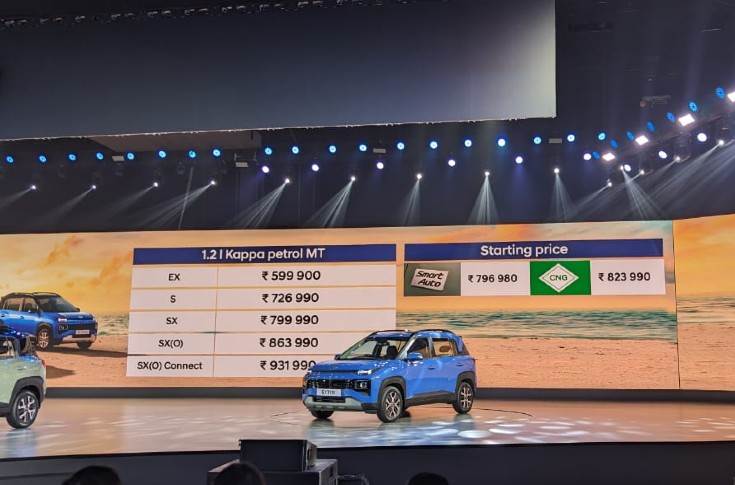Hyundai Motor India (HMIL) has introduced its mini-SUV – Exter – launched at an introductory price of Rs 5,99,900, ex-showroom, India. The Exter is gunning for the Tata Punch, its sole rival in the sub-four-metre entry-SUV sub-segment, aiming to raise the benchmark with unique product attributes.
The Exter is targeted at young, Gen-Z customers keen on a spacious, yet urban-friendly car in an SUV body style. HMIL, which opened bookings of the Exter on May 8 and began production at its Sriperumbudur plant on June 24, claims to have received over 11,000 bookings until launch on July 10.

The company says that the entry-SUV segment within the sub-four-metre segment has emerged as one of the strongest growing categories, and it aims to tap into this potential with the Exter. In FY2023, the sub-four-metre compact SUV segment clocked sales of over a million units (10,02,864 units) and accounted for exactly 50% of the passenger vehicle market’s record UV sales or 20,03,718 units. In the compact SUV category, the Tata Punch, with sales of 133,819 units, had a 13% market share.
Led by the Tata Punch, entry SUVs comprised a 14% share of the sub-four-metre SUV segment in CY2022. HMIL says the Exter will grow the contribution to 16% in the remaining half of CY2023, with an estimation of the entry SUVs touching 20% volumes within the sub-four-metre SUV category in CY2024.
According to Tarun Garg, Chief Operating Officer, HMIL, “We are raising the benchmark in this segment. Starting from the Santro, which was not the first in its segment, we were able to raise the benchmark. Similarly, the Exter is another model which is going to be a big game changer, not only for Hyundai Motor India, but the industry.”
“We will elevate all standards in terms of safety, features, and design with this new product. There is presently only one model averaging around 10,000 units every month. With the foray of the Exter, we believe that the entry-SUV segment volumes can double in the next one-and-a-half year. It is a high-potential segment, as it cuts across multiple vehicle categories, including hatchbacks, and compact sedans, and there is a high likelihood of the Exter appealing to not only the existing SUV customers but also hatchback buyers in the market,” he added.
Boxy looking, feature-laden SUV
The Exter follows Hyundai’s ‘Parametric’ design language that employs boxy proportions and an upright stance. At the front, the mini-SUV gets a split-headlamp setup with integrated ‘H’-shaped LED DRLs. The front fascia gets a wide, contrasting black grille, and a prominent chin with a faux silver skid plate. The side profile is characterised by flared wheel arches, diamond-cut alloy wheels, clean lines, and all-around body cladding that lends a robust look.
The Exter gets LED tail-lights at the rear, a shark-fin antennae, roof rails as well as a single-pane sunroof – a first-in-segment feature. On the inside, the car gets an 8.0-inch touchscreen infotainment system with over 60 connected car features under Hyundai’s Bluelink connectivity suite, as well as OTA updates. Hyundai also offers a factory-fitted dual-monitoring dashboard camera, as well as cruise control on the Exter.
The Exter is offered in five trim levels, all with six airbags and electronic stability control (ESC) – the two key requirements to score a four- or five-star rating in GNCAP’s latest crash protocol – as standard safety kit. The Exter comes powered by a sole 1.2-litre, 82hp, four-cylinder, naturally-aspirational petrol engine, coupled with 5-speed MT or AMT options.
While Hyundai is claiming a fuel economy rating of 19.4kpl for the manual and 19.2kpl for the automatic, the factory-fitted CNG option offers a much superior fuel economy of 27.10kpl in comparison. According to the company, almost 38% of Exter’s initial bookings are for the AMT variants, while 20% for the factory-fitted CNG trims.
Exter EV as a brand extension
With an all-electric Tata Punch in the pipeline, Hyundai could also consider introducing an EV version of the Exter and position it as the most-affordable EV offering in its portfolio, which at present relies on locally-assembled premium EVs, including the Kona EV and Ioniq 5. The company has already announced an investment of Rs 20,000 crore in Tamil Nadu to set up a local battery assembly plant, which is expected to go on stream next year.
“Launching mass-market EVs requires a huge focus on localisation, and this is a very big step in that direction. We are adopting a two-pronged strategy, wherein alongside the investment in local battery assembly, we are also setting up charging infrastructure to enable faster and easier adoption of EV technology in the country,” Garg said.
“We are strongly focused on electrifying our portfolio, and we are very confident about our future in the EV space in India,” he signed off, without confirming plans for an electric Exter. Nevertheless, India’s booming compact SUV market just turned more exciting with the Exter. Over to the buyer now.
